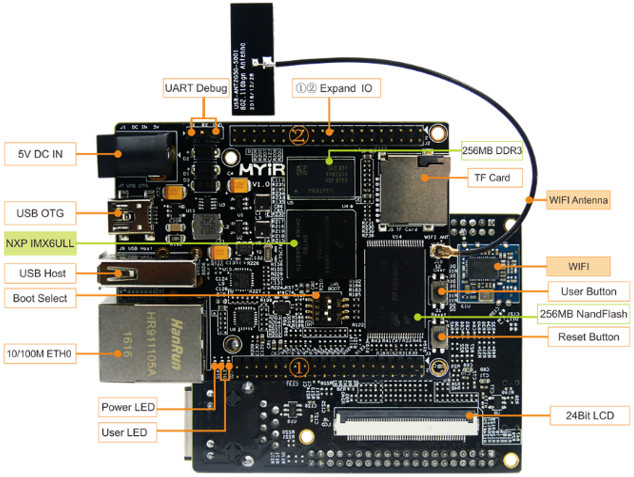MYIR Tech has released MYS-6ULX single board computer based on NXP i.MX 6ULL/6UL Cortex-A7 processor designed for either Industry 4.0 with MYS-6ULX-IND model, or the Internet of Things for MYS-6ULX-IOT. Both boards include 256MB DDR3 SDRAM, 256MB NAND flash, USB, USB, Ethernet, LCD interfaces and more, in a compact 70 x 55mm form factor.

Both boards have very similar specifications.
| Features | MYS-6ULX-IND | MYS-6ULX-IOT |
| SoC | NXP i.MX 6UltraLite (MCIMX6G2CVM05AA) with an ARM Cortex A7 processor @ up to 696 MHz and 2D graphics accelerator | NXP i.MX 6ULL (MCIMX6Y2DVM05AA) with an ARM Cortex A7 processor @ 528 MHz and 2D graphics accelerator |
|
DDR3 |
256MB (support up to 2GB) | |
| NAND Flash | 256MB (support 512MB/1GB) | |
| eMMC | DNP (Do Not Populate – Reserved design for optional 4GB flash) | |
| Ethernet | 10/100Mbps | |
| USB | 1x USB Host, 1x micro USB OTG | |
| Micro SD Card | 1x Micro SD card slot | |
| Buttons | 1x Reset Button, 1x User Button | |
|
LED |
1x Power Indicator, 2x User LEDs | |
| LCD Connector | 24-bit RGB LCD & Touch Screen (50-pin FPC connector) | |
| Debug Connector | 2.5mm pitch 3-pin Headers, TTL | |
| Expansion Headers | Two 2.0mm pitch 2x 20-pin headers with 1x Ethernet, 8x UARTs, 4x I2C, 2x CAN, 4x SPI, 8x ADC, 4x PWM, 2x I2S, 1x 8-bit Camera, 1x JTAG, up to 46x GPIOs | |
| WiFi Module | – | USB based, 2.4GHz, IEEE 802.11b/g/n standards |
| Dimensions | 70mm x 55mm | |
| PCB Layer | 8-layer | |
| Power Supply | 5V/1A | |
| Power Consumption | About 5V/0.25A (single board) About 5V/0.4A (board + 4.3” LCD) About 5V/0.8A (board + 7” LCD) |
|
| Working Temp. | -40°C~85°C | 0°C~70°C |
| Target Applications | Industry 4.0 | IoT |
So the main differences between the industrial and IoT versions are the use of i.MX 6UL processor and a wider temperature range for the former, and NXP i.MX 6LL processor and an extra WiFi module for the latter. Both boards run Linux 4.1.15 with Debian or Yocto + Qt images and BSP. The company has also implemented a demo using Amazon Alexa Voice Service available to customers.

Sample price for the boards is $26.80 for MYS-6ULX-IND, and $24.80 for MYS-6ULX-IOT, which you can purchase directly via the product page together with optional optional 4.3″ or 7″ LCD modules.

Jean-Luc started CNX Software in 2010 as a part-time endeavor, before quitting his job as a software engineering manager, and starting to write daily news, and reviews full time later in 2011.
Support CNX Software! Donate via cryptocurrencies, become a Patron on Patreon, or purchase goods on Amazon or Aliexpress




